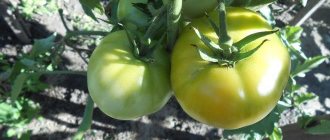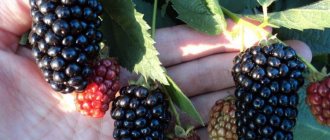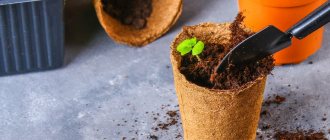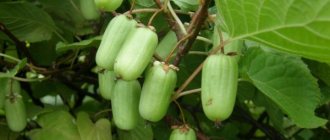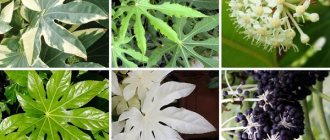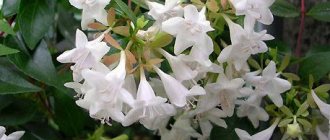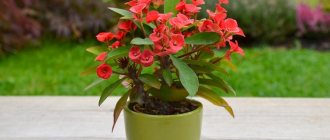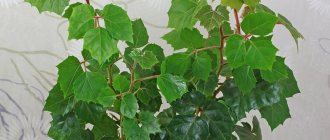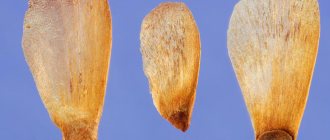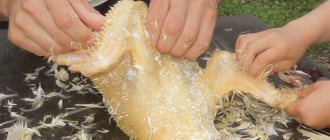What is a fern
Ferns or mosses are among the most ancient representatives of the plant world of planet Earth. They once grew as tall trees, but today they grow as low shrubs, about 1 meter high. Reproduction of ferns, such as ostrich, horsetail, and bracken, occurs with the help of spores that form on the back of the leaf blades.
Indoor fern - decorative foliage plant
How do ferns reproduce in nature?
The development and reproduction of ferns in the wild takes a little longer than at home. The plant reproduces by spores or brood buds. Each season, plants of the Fern class form spores and go through sporophyte and gametophyte cycles.
Scheme and description of fern propagation naturally independently in nature:
- the formation of sporangia on fern leaves, within which spores form;
- after their complete formation, they are separated from the plates and spread in the water or around the area with the help of the wind;
- under good climatic conditions, a shoot grows from them, which, with the help of its rhizoid, is fixed in the ground;
- on the underside of this growth female and male reproductive cells appear, within which fertilization occurs;
- soon a zygote is born, which forms its root system and grows into the soil.
Note! Spores form only on spore leaves, and ferns also have sterile or asexual plates.
Selecting soil and growing containers
In order for the planted sprout to take root well, it is necessary to select the optimal pot and soil in which the plant will grow. Soil can be purchased either in a specialized store or made independently. But in order to sow spores into the soil, you should make sure that there are special components in the soil.
For the optimal composition of the soil substrate, the following list of ingredients will be required:
- River sand and high-moor peat are brown in color. To combine the soil substrate you will need 1 part sand and 3 parts peat.
- Leaf soil, river sand and peat in a ratio of 1:1:3, respectively.
River sand and leaf soil are taken in identical proportions (1:3).
For good rooting and rapid development of the root system, you can also use soil for violets. It contains the optimal amount of all nutrients required for planting a young fern sprout.
To plant spores, the soil requires specific preparation. Initially, the earth is sifted, all large stones and solid particles, and various debris are removed from it. Experienced gardeners recommend disinfecting before rooting.
To do this, you need to wash the soil with a weak solution of Potassium Permanganate and place it in one layer on a baking sheet in the oven. The soil should be sterilized within several hours. Only after this can you prepare the planting container. If fern propagation is carried out by spores, then for sowing you will need a shallow, rectangular pot made of plastic or glass.
When planting plant sprouts in regular peas, you can choose any options. A clay container works great. It has the ability to absorb moisture. And, as needed, give it back to the soil. But you shouldn’t overwater the flowerpot. This situation can provoke the development of a fungal infection, which is very difficult to remove from a clay pot.
You can also use plastic containers for planting. But you need to remember that it is very unstable and does not allow air to pass through. Therefore, it is worth selecting large pots, but so that they are half the size of the total volume of fern branches. And in order for the plant to receive a sufficient amount of air, it is worth loosening more often.
Basic ways to get a new plant at home
Types of ferns - indoor and house plants
At home, ferns can be propagated in the garden in many ways. As a rule, they belong to the vegetative and spore method. Mosses propagate vegetatively by rooting lateral aerial shoots, planting brood buds and dividing the mother bush into several parts. The spore method involves collecting formed spores and sowing them in the ground.
Which method is the most effective
All methods are widely used by fern owners, so it is difficult to say exactly which one is more effective. If you choose a method with a higher survival rate, then it is spore sowing. However, it takes a long time.
The effectiveness of the method is determined by the type of fern, since each variety differs in its morphological structure.
Separation of the root system of an adult bush
Indoor fern - environmental inspector
Indoor ferns , like their wild relatives, are considered unpretentious plants. But, nevertheless, not in all conditions they will grow well and look attractive. In the forest, ferns thrive on sandy and especially peat soils. Moreover, without daily watering, in the heat, without replanting or pruning. But in an urban environment, even in good soil they can wither away. Why? Because ferns are a kind of indicator of the purity of the atmosphere.
Ferns do not tolerate gas pollution and smoke in the atmosphere very well, they react to dry air, and if you decide to have an indoor Fern at home, then first of all provide it with access to fresh air. But on the other hand, if you bought this flower, and at home it began to wither, this is a reason to wonder if everything is in order in your apartment. Maybe there's a gas leak somewhere or it's time to install a hood in the kitchen. In addition, the indoor fern may dry out due to low air humidity - this is a hint to you that it is time to buy a humidifier or at least place a couple of vessels with water in the house for evaporation.
- Photo of indoor asparagus with names
How and when to divide a bush
One of the most effective and shortest vegetative methods of propagation of club mosses is the division of an adult bush. Before carrying out this procedure, it is necessary to water the bush generously with water at room temperature in order to easily pull it out of the ground without damaging the root system.
What is the structure of a fern - features of the leaves and roots of ferns
How to propagate indoor fern by dividing the bush:
- Dig holes 40-60 centimeters deep in advance. Their bottom is covered with drainage material, and the top is sprinkled with soil mixture.
- Pull the plant out of the old soil and divide it into several equal parts.
- Each of them is planted in a separate hole or pot.
Thorough root watering is carried out once a week and watered from above twice using a watering can.
Important! You cannot divide a young bush with one root rosette.
Spores on the underside of leaves
In the garden and aquarium
Some species can be grown in open ground and in water. We talked more about common types of ferns in a separate article.
Garden
Adiantum, Multirow, Ostrich, and Kochedyzhnik are suitable for growing in open ground.
These species are unpretentious and shade-tolerant. All care for these ferns comes down to watering, loosening and mulching the soil. They should be planted in a peat-sand mixture. The main condition is that the area should not be waterlogged or flooded with melt water.
Also, due to their winter hardiness , Bubblewort, Shieldwort, Osmunda and Bracken are suitable for the garden.
The garden species is replanted every three to four years.
Aquarium
Aquarium fish lovers are familiar with the varieties of ferns grown in aquariums. It is a real decoration of the reservoir and looks very impressive. The optimal temperature is 23-27 degrees.
If the water is colder, the leaves become small and lighten. Hard water also destroys it. Coarse sand or gravel is suitable for cultivation. They don't need feeding. Daughter shoots separate from the mother plant on their own and emerge. After this, they can be rooted again.
Aquatic ferns include Salvinia and Azola.
How ferns reproduce by spores
Types of ferns and their classification
This method is most effective in the spring after the soil has warmed up. Sowing in a pot is done in autumn or early spring.
How fern reproduces using spores at home:
- Moisten the soil with a spray bottle.
- Sprinkle spores on top.
- Sprinkle a 3-centimeter layer of soil on top.
- Cover the top with glass or plastic containers, since it is necessary to create a greenhouse effect.
- When sprouts appear, you will need to remove the cover every day for 2 hours.
How to root side shoots
Arrows in the form of tendrils appear on the leaf blades of garden ferns, which can be rooted in the ground. Next to the plant in which this green arrow has formed, you need to place a separate container with a nutrient substrate. It is important that this container is either the same height or slightly lower than the pot with the mother plant.
Two containers are placed side by side and a side shoot with a healthy and stable tendril is bent towards the ground. Lightly dig it in with soil. If necessary, secure with a pin or wire. After this, it is thoroughly moistened and both containers are left in a well-lit place.
Interesting! After 1.5-2 months, the arrow will take root and become well established in the soil. It can be separated from the main bush and moved to another place. If necessary, transplant a small seedling into another container.
Brood buds form on leaf blades
Reproduction by shoots
Vegetative propagation of ferns occurs with the help of long fluffy arrows that appear on the plant from time to time.
With these shoots, the fern can be propagated as by layering. To do this, the shoot is pinned to the soil or pressed down with a pebble. Here it would be appropriate to use wet moss for rooting. This procedure is performed exclusively in spring, when the weather is cool and the plant is actively developing. With sufficient moisture content, after a few weeks the shoots will take root and the development of a new plant will begin. The newly formed plant can be separated from the main one (mother plant) and planted separately.
How to propagate fern using brood buds
Another vegetative way by which a fern can reproduce at home is by planting formed buds on the leaves in the ground. Fern-like plants have the ability to grow lateral shoots on the petioles of their leaf blades. You cannot plant an unformed bud; it must produce small roots.
Carefully separate one shoot at a time and place them in a box with substrate. Moisten the soil and place it in a warm and bright place. It is necessary to create a humid microclimate for the growth of buds, so at first they can be covered with film.
As soon as the seedlings have 2-3 leaves, you can remove the film and plant them in separate containers.
Important! You should not immediately transplant the seedlings into a huge pot. During the first years of growth, the fern will still have to be moved to larger containers each spring.
Characteristics of species
Some species are decorative, others have medicinal properties, are used in cooking, and there are also poisonous specimens. They are divided into aquatic and terrestrial, depending on the place of growth. Arboreals are representatives of the largest group. The most common types of indoor and garden ferns:
- Adiantum reniform is a miniature species up to nine centimeters high. The leaves are round in shape and acquire a border of brown dots when the spores ripen. An extremely whimsical plant. It is difficult to tolerate changes in location, position, irregular watering and waterlogging, temperature drops below fifteen degrees, and direct sun exposure. Requires a certain soil composition. It grows actively in favorable conditions: in humidified air, with periodic spraying, and annual replanting. Popular varieties:
- Victoria elegans - feathery leaves of oval or triangular shape, short wedge-shaped leaves up to six millimeters, reddish stems;
- Fritz Luthi - with triangular small wedge-shaped leaves up to thirty centimeters long, forming a lush crown;
- Fragrans - characterized by rapid growth and the formation of dense bushes with numerous fronds;
- Fragrantissima - the diameter of the crown of a houseplant reaches one and a half meters, large triangular leaves reach sixty-five centimeters in length and up to thirty in width.
- Maidenhair maidenhair is delicate, refined, with small rounded dissected leaves on thin stalks.
- Blekhnum - belongs to the family of loosestrife, united in two hundred decorative species. Leathery, palm-like fronds about a meter long. The powerful rhizome turns into a shortened stem, at the top of which there are lush light green leaves. Oval with elongation, deeply cut, feathery, dissected lobes. Paired spores are located along the main veins on the inside. Some specimens are similar to a low palm tree due to the ability of the trunk to reach half a meter.
- Asplenium is a common indoor fern. At home it has large leaves with a variety of species, light green in color. Short creeping rhizome with delicate scales. Leaf shape: entire, triangular, dissected, pinnate, xiphoid, with wavy edges.
- Davallia - young leaves of a rich green color, dissected into jagged elongated sectors. More mature ones have a yellowish tint. Formed throughout the growing season. In autumn, growth slows down, going into a dormant state. With lengthening daylight hours, growth is restored. It is distinguished by the presence of thickened creeping brown roots with silvery down. They grow upward and can hang from a hanging basket. The length of the roots reaches eighty centimeters.
- Scolopendra leaf is a perennial, it is called “deer tongue”. Homeland - Mediterranean regions of Eurasia. It grows in rocky crevices and on limestone screes. The root has a layer of film with scales. Leathery, petiolate fronds are collected in a bunch up to seventy centimeters long. A belt-shaped leaf with a voluminous central vein and a heart-shaped base. Petiole with short brownish-green hairs. Groups of sori are extended along the leaf blade, perpendicular to the central vein. Species diversity is presented with smooth, corrugated, wavy, comb, branched, forked, curly edge of the frond.
- Nephrolepis sublime or Boston is the most unpretentious, compact of the oleander family. Includes more than thirty species. Epiphytic or terrestrial with light green decorative fronds. On the vertical rhizome there is a rosette of large short-petioled pinnate branches up to eighty-five centimeters. Scaly shoots form on the roots, which take root and form new flowers.
- Pteris - represents two hundred and fifty subtropical and tropical species. The leaves are graceful, of different sizes and contours, green, variegated (variegated) colors. Easy to care for, prefers high air humidity.
- Platycerium is an unusual genus with eighteen species, found naturally in the tropics. Grows on tree trunks and branches. Has two types of sheet with specific functions. The first is like a pocket to collect moisture, nutritious fallen leaves and insects to feed and serve as support. There are no disputes. The second ones are visually spectacular, similar to the antlers of a deer. The structure comes in varieties, up to one meter long.
- Pellea rotundifolia is a button fern with eighty species. Found in temperate, tropical, subtropical zones. It is a small bush with leathery, shiny, round leaves of dark green color. Creeping, scaly root. The shoots are fleecy. Petioles no more than one millimeter.
Features of caring for sprouted ferns
Subsequent care of the fern after reproduction consists of the following activities:
- Air humidity. Small seedlings after transplantation are especially sensitive to humidity. It is necessary to try to maintain it at high levels, especially in winter with additional heating of the room. Every day you need to spray the bushes with a spray bottle, and if the air is particularly dry, the procedure can be repeated several times a day.
- Regular watering on schedule. You cannot violate the regime and ignore this procedure, but there is no need to overwater the plants. Young seedlings are especially susceptible to root rot due to stagnation of water in the soil. When planting, it is recommended to first cover the drainage at the bottom of the pot and only then fill in the substrate. Also, do not forget to drain excess liquid from the pan.
- Feeding. It is better to apply fertilizers in liquid form, dissolving the preparations in plain water and in low concentration. The procedure is carried out once every two weeks. It is necessary to use complex mineral preparations for fern-like shrubs. During this period, all minerals are necessary for the normal development of the plant, especially nitrogen, which helps to build up green mass.
- Lighting should be long, but slightly diffused, so as not to burn the delicate leaves. You need to place the box with seedlings on the south window in winter and move it to the east or west side with the arrival of warm, clear days.
- Temperature conditions. The most optimal indicators during this period are considered to be 22-25 ℃.
House ferns easily take root after propagation at home
Indoor ferns are decorative deciduous evergreen shrubs that have a pleasant appearance and can refresh any dull interior. It is placed in offices and other rooms to add coziness. Propagating ferns is an easy and effective process that can be done in many ways. The main thing is then to provide the seedlings with attentive and proper care so as not to completely lose all the planting material planted.
Light, humidity and temperature for the plant
In order for the shrub to quickly develop and grow its ground crown well, it is recommended to adhere to certain requirements:
- Lighting – ferns of any variety require a large amount of diffused light. The bush can live in the shade of other plants, but then its appearance will not be so bright, noble, and the shade will not be saturated. But at the same time, the direct rays of the luminary scorch the delicate petals of the plates. Therefore, it is recommended to choose a location for the flowerpot so that the sun’s rays fall on the plant in the morning and evening, and in the heat of the afternoon the bush remains in the shade.
- Temperature - the most suitable temperature for fern living is 16.. 23 C. In winter and summer, the degrees in the room where the plant is located increase noticeably. Therefore, it is worth spraying the area next to the bush. This will saturate the leaf plates with nutritious moisture. The minimum temperature at which a fern can survive is 5 C. A further decrease in degrees will only lead to the death of the bush.
- Humidity - spraying the plates must be done every day, especially in winter, when the room is overdried by heating devices. To increase humidity, you need to take a small towel and place it on the radiator after wetting it.
Not only will the formed microclimate be suitable for the plant, it will also be favorable for people.
